(Adding categories) |
m (→Neutral Jump) |
||
| Line 58: | Line 58: | ||
== Neutral Jump == |
== Neutral Jump == |
||
| − | [[File:Neutral.gif|thumb|158x158px| |
+ | [[File:Neutral.gif|thumb|158x158px|A player doing a neutral jump. Note that it does not use stamina.]] |
A '''neutral jump''' occurs when the player jumps away from a wall without inputting a direction or holding down the grab button, which causes the player to jump away from the wall by a smaller distance than a wallkick. This can allow the player to move back to the wall at the peak of the neutral jump, resulting in a higher vertical position. Unlike a climb-jump however, neutral jumping does not use up stamina, but nevertheless allows the player to travel vertically up the wall. Neutral jumps can also allow the player to climb walls when out of stamina or if the wall cannot be traversed with climb-jumps. |
A '''neutral jump''' occurs when the player jumps away from a wall without inputting a direction or holding down the grab button, which causes the player to jump away from the wall by a smaller distance than a wallkick. This can allow the player to move back to the wall at the peak of the neutral jump, resulting in a higher vertical position. Unlike a climb-jump however, neutral jumping does not use up stamina, but nevertheless allows the player to travel vertically up the wall. Neutral jumps can also allow the player to climb walls when out of stamina or if the wall cannot be traversed with climb-jumps. |
||
Revision as of 20:13, 21 May 2022
Celeste contains a large array of unique moves and techniques, which range from simple inputs to gain speed to advanced jumps that can allow you to skip large sections of levels.
Note: Most of the moves don't have official names, so for simplicity, they're going to be called by the names the community came up with. However, since some names are up for debate (ex. Wallbounce, Super-Walljump, Master Walljump, etc.) this page is going to call them by their most popular name.
Super / Reverse Super

A reverse super in Reflection C-Side
A super is performed by dashing on the ground followed by a jump, which results in a long-distanced jump.
A reverse super is a super in the opposite direction, which can be done by switching directions when jumping (ex. dash right, then jump left). A super travels the same distance as simply jumping and then dashing, so supers tend to not provide much benefit to the player outside of speedrunning.
Extended Super / Reverse Extended Super
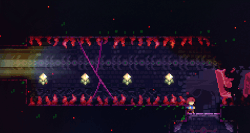
An Extended Reverse Super used to skip a large part of Mirror Temple A's 4th subchapter
After dashing, Madeline's hair turns white for a small window before it becomes red again. If you do a super and jump while Madeline's hair is white, you can do a super and retain your dash, which is called an extended super. The ability to retain a dash after a super can allow the player to cross larger gaps than a normal super could.
The player can also reverse an extended super to do a reverse extended super, which can allow the player to re-position themselves or do an extended super off of a wall next to the ground. Notably, a reverse extended super is used in certain speedruns to skip a large part of Mirror Temple's A-side's 4th subchapter, forgoing the need to collect the sub-chapter's keys.
Hyper / Reverse Hyper

Core C's first room
A hyper is performed by dashing down diagonally and then jumping before the dash ends. Hypers function much like supers, but give the player an increase in speed that is significantly greater than either a super or dash. Madeline travels lower when performing a hyper, allowing her to jump through tighter gaps than a super. However, this lower jump height may cause the player to hit obstacles that are low to the ground if they are not careful. This move is first introduced to the player in Chapter 8's C-side, but is only used in two sections (once at the beginning of the level and once again at the end of the final room).
As with supers, it is possible to do a reverse hyper by switching directions when jumping, although this has limited practical value.
Extended Hyper / Reverse Extended Hyper
An extended hyper functions identically to an extended super in that Madeline retains her ability to dash after jumping. This move is performed by doing a hyper, but only jumping after Madeline's hair becomes red again. An extended hyper can allow you to cross even larger gaps and is used in many cases in speedrunning to go extremely fast, as there is no known limit to Madeline's downward diagonal speed, meaning that you could do multiple hypers/wavedashes in a row, which would allow you to gain massive amounts of speed.
Extended hypers can be reversed to do a reverse extended hyper. Notably, a reverse extended hyper is used in speedruns of the Chapter 5 A-side to perform the YEET, which allows speedrunners to skip through two otherwise slow rooms in a short amount of time.
Wavedash / Reverse Wavedash

Wavedash from right -> left, and extended hyper left -> right
A wavedash can be performed by dashing down diagonally after a jump and then jumping almost instantly after landing. While a wavedash is similar in function to an extended hyper, it can be used in different scenarios. Unlike an extended hyper, it is possible to perform a wavedash on one single tile, while an extended hyper requires either more space or an adjacent wall to be performed. Wavedashes can also be reversed, much like extended hypers. Wavedashes are formally introduced to the player in Chapter 9's 5th sub-chapter, Event Horizon.
The relatively high technical difficulty of the wavedash may result in two common issues: the wavedash not performing, and the failure to retain the dash afterwards. The former is a result of the player initiating the downward diagonal dash too high off the ground. In this case, the dash has already finished once the player has touched the ground, thus resulting in a failure to perform the wavedash. The second problem, in which the wavedash is performed but without the retaining of the dash, is a result of the player initiating the downward diagonal dash too low off the ground. By jumping before Madeline's hair turns white, the dash is unable to be reset.
Wallbounce
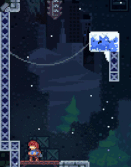
A wallbounce in Chapter 1.
A wallbounce occurs when the player dashes upwards when adjacent to a wall and then jumps during the dash. The jump can be done at any time up until the end of the dash, causing the wallbounce to travel higher the longer the jump is delayed. Wallbounces allow the player to travel vertically more quickly than a dash or wallkick, and can be used in multiple levels to complete them faster. This technique is taught and used in Chapter 7's B-Side, as well as Chapter 9, and is required to complete the C-Sides (excluding 1C, 2C, and 8C) and Chapter 9.
Ultra
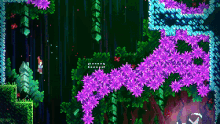
A reverse hyper transitioned into a downwards ultra and a bunny hop, in Chapter 6's 5th subchapter.
An ultra is an oblique dash that occurs when performing a diagonal-down dash when already moving with a high horizontal velocity. This causes the player to maintain their speed and get a speed boost upon hitting the ground. Using a diagonal-up dash instead results in an "upwards ultra", which has the key difference that the momentum ends when the dash does — the momentum does not carry.
Demodash
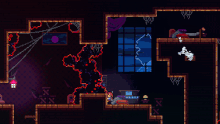
A demodash performed in Chapter 3's Elevator Shaft subchapter.
A demodash (named after its discoverer, DemoJameson) is performed by dashing down, then immediately (within 4 frames or 0.066 seconds, 0.068 seconds of in-game time) releasing the down key. This causes Madeline to dash horizontally while keeping a crouched state at the same time. Being crouched reduces the size of the player's hitbox, allowing them to fit through gaps that could not be travelled through under normal circumstances. If one not only releases the down key, but also inputs other directions, a demodash can be done upwards or diagonally up.
Since v1.4.0.0, the keybind "Crouch Dash" simplifies this move. With this keybind, a demodash can be performed by holding the key of the desired direction and pressing Crouch Dash.
Demohyper
Attempting to perform a super out of a demodash will result in a hyper instead because the game checks for whether Madeline is crouched to determine which to perform. This hyper is referred to as a demohyper. Demohypers are slightly faster than ordinary hypers, because the player has greater horizontal velocity before it begins due to being in a horizontal dash rather than a diagonal one.
Coyote Time
Celeste has a "coyote time" mechanic where the player can jump in the air for 5 frames after falling off a platform. This can be used to obtain the maximum possible distance from an extended hyper. Coyote time also affects the jump used to trigger a hyper, allowing one to start the hyper from midair from a short distance beyond a platform.
Cornerboost

Reverse hyper into bunnyhop into a cornerboost, which launches Madeline through the next room.
A cornerboost can be performed if the player climb-jumps off the top 5-7 pixels of a wall (usually 7 if the player is moving slowly, 5 if the player is moving quickly) with the right timing, this allows the player to maintain any previous horizontal momentum after the climb-jump.
Neutral Jump
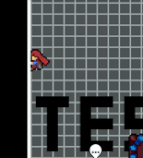
A player doing a neutral jump. Note that it does not use stamina.
A neutral jump occurs when the player jumps away from a wall without inputting a direction or holding down the grab button, which causes the player to jump away from the wall by a smaller distance than a wallkick. This can allow the player to move back to the wall at the peak of the neutral jump, resulting in a higher vertical position. Unlike a climb-jump however, neutral jumping does not use up stamina, but nevertheless allows the player to travel vertically up the wall. Neutral jumps can also allow the player to climb walls when out of stamina or if the wall cannot be traversed with climb-jumps.
Spikejump

Wall spikejump in Chapter 3's Huge Mess.
A spikejump is a wallkick or neutral jump performed on a corner covered with spikes. This is possible because spikes do not harm Madeline when she is moving in the same direction they are pointing. As long as Madeline is moving in the same direction as the spikes, she can wall kick off of the wall behind the spikes. Spikejumps are often used in speedruns, most notably to skip a large part of the Chapter 5 B-Side's 2nd subchapter.
Ceiling Spikejump
Spikejumps are also possible off of downward-facing corners. This is somewhat easier than a standard spikejump because it exploits the "ceiling pop" mechanic in which, when hitting the edge of a wall while moving upwards, the game will move Madeline left or right by up to 5 pixels in an attempt to avoid the wall.
Screen Transitions
Although not a move of its own, the exploiting of screen transitions is taught to the player by the game indirectly when figuring out how to get Chapter 2's Crystal Heart. When moving between screens, the game will reset the player's dash, allowing for unintended uses in many places to skip parts of a room, such as the first room with a key in Chapter 3's A-Side.
